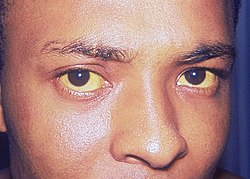Jaundice
Jaundice (icterus) refers to a yellow pigmentation of skin, sclerae, and mucosa due to a raised plasma bilirubin (visible when plasma bilirubin >35 μmol/L).
Class: According to site of the problem
• Pre-hepatic
• Hepatic
• Post-hepatic
Other classifications: By the type of circulating bilirubin (conjugated or unconjugated)
Bilirubin Metabolism
Bilirubin is formed from the breakdown of haemoglobin. It is conjugated with glucuronic acid by hepatocytes, making it water soluble. Conjugated bilirubin is secreted into the bile and passes out into the gut. Some is taken up again by the liver (enterohepatic circulation) and the rest is converted to urobilinogen by gut bacteria. Urobilinogen is either reabsorbed and excreted by the kidneys, or converted to stercobilin, which colours faeces brown.
Types[edit | edit source]
Pre-hepatic
Due to increased destruction of Red Blood Cells
Causes: Physiological (neonatal); haemolysis; dyserythropoiesis Increased unconjugated bilirubin.As it is water insoluble, it does not enter urine. We see dark stool& normal urine.
Hepatocellular
Due to liver damage(hepatocyte damage). Causes: Viruses such as hepatitis, CMV, EBV, drugs overdose and Anti-TB (isoniazid, rifampicin, pyrazinamide) Alcoholic hepatitis leading to cirrhosis. Liver metastases/abscess; haemochromatosis; autoimmune hepatitis (AIH); A1-antitrypsin deficiency Wilson's disease
Post hepatic (also called cholestatic/obstructive)
Due to stone obstruction of common bile duct&pancreatic cancer(head of pancreas) Causes: Gallstones in the common bile duct; pancreatic cancer; lymph nodes at the porta hepatis; drugs: Antibiotics (flucloxacillin, fusidic acid, co-amoxiclav, nitrofurantoin),Oral contraceptives cholangiocarcinoma; sclerosing cholangitis; primary biliary cirrhosis (PBC); Failure to excrete conjugated bilirubin(conjugated hyperbilirubinaemia) It´s water soluble, so excreted in urine, making it dark (dark urine). Less conjugated bilirubin enters the bowel and the faeces becomes pale (pale stools).
Clinical features[edit | edit source]
Signs of chronic liver disease
- Hepatic encephalopathy (due to liver failure to break down toxic substances)
- Lymphadenopathy
- Hepatomegaly
- Splenomegaly
- Palpable gall bladder(can suggest ca of pancreas) and ascites.
- Pale stools & dark urine in obstructive jaundice.
Diagnosis for Signs[edit | edit source]
Ask about blood transfusions, intravenous drug use, body piercing, tattoos, sexual activity, travel abroad, jaundiced contacts, family history, alcohol consumption, and all medications (eg old drug charts; GP records). Tests Urine Haematology: FBC, clotting, etc Biochemistry: U&E, LFT1, bilirubin, ALT, AST,. Virology: EBV, CMV, HAV, HBV, & HCV serology. Other specific tests, e.g for haemochromatosis, antitrypsin deficiency, Wilson's disease (increased serum copper)
Ultrasound Perform a liver biopsy if the bile ducts are normal. Consider abdominal CT or MRI scan.
Links[edit | edit source]
Related Articles[edit | edit source]
Bibliography[edit | edit source]
References[edit | edit source]
KUMAR, – CLARK,. Kumar and Clark's Clinical Medicine, 8th Edition. 8. edition. 2012. ISBN 9780702044991.



